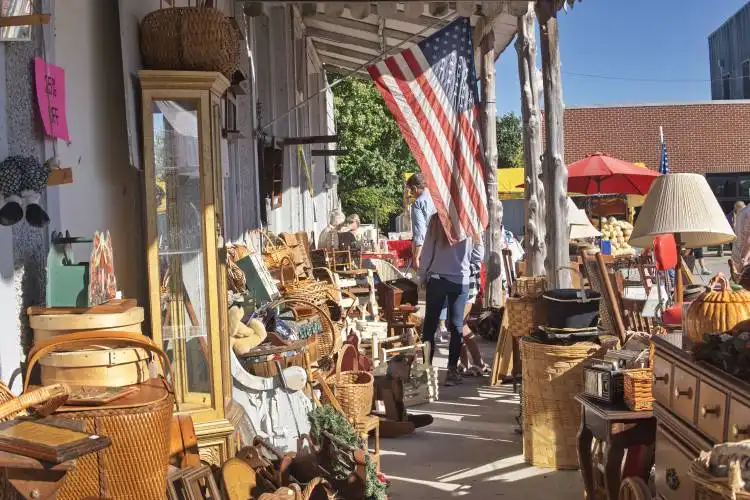Start a Pawn Shop
Running Your Own Treasure Trove: The Adventure of a Pawn Shop Business
| Updated


PAWN SHOP
Ever thought of running your own treasure trove? Then diving into the pawn shop business could just be your golden ticket! A pawn shop offers customers a chance to sell, buy, or loan items, acting almost like a miniature, everyday auction house. From vintage watches to electric guitars, every day is a truly unique experience, striking the perfect balance between helping people in a tight financial spot and indulging in an exciting, treasure-hunting expedition!
Jump to Business Plan
RELATED BUSINESS IDEAS
Browse ALL Retail & Shopping Business Ideas
Discover Your Perfect Domain
Unlock the door to your online success with our hand-picked selection of premium domain names. Whether you're starting a new venture or rebranding an existing one, the right domain can set the tone for your digital presence. Browse through our curated list, each with its unique potential to enhance your brand's visibility and credibility.
PAWN SHOP MINI BUSINESS PLAN
This a quick reality check to help you identify the strengths and weaknesses of your business concept before you dive in.
Pawn Shop Business Analysis
Expected Percent Margins:
- Gross Margin: 40-60%
- Net Profit Margin: 15-30%
Earnings Expectations:
- Daily Earnings: $500 - $1,000
- Weekly Earnings: $3,500 - $7,000
- Monthly Earnings: $14,000 - $30,000
- Annual Earnings: $168,000 - $360,000
Actions to Achieve These Numbers:
Inventory Management:
- Initial Capital: Prepare an up-front investment of $50,000-$100,000 for inventory.
- Repairs and Maintenance: Make a deal with a reliable repair shop for maintaining and repairing your goods.
Operations and Legislative Requirements:
- Licensing: Obtain the requisite pawnbroker licensing and meet all local and federal legal requirements.
- Insurance: Secure comprehensive insurance coverage to mitigate risk.
Marketing and Customer Acquisition:
- Local Marketing: Invest in local advertisements, fliers, and partnerships with community businesses.
- Online Marketing: Develop an online presence through social media, Google My Business, and a dedicated website.
Sales and Customer Experience:
- Staff Hiring & Training: Hire and train staff to assess items for pawning and purchase.
- Customer Service: Customer satisfaction is vital – focus on providing personalized customer service.
Cost Management:
- Rent/Mortgage: Lock in a leased location or a purchased property, ensuring rent/mortgage is less than 15% of expected revenue.
- Utilities: Expect to spend around 5-10% of monthly earnings on utilities, insurance, and miscellaneous expenses.
Revenue Generation:
- Transaction Volume: Aim for 20-40 transactions per day with an average transaction value of $25-$50.
- Interest Income: Interest on pawned items could range from 15-25%, which can be a significant revenue stream.
Remember, real-world results can vary based on local market conditions, competition, and specifics of your business plan.
NOT WHAT YOU HAD IN MIND? Here are more ideas



Browse ALL Retail & Shopping Business Ideas
Grab Your Business Website Name
Before you get caught up in the whirlwind of setting up your business, invest in a domain name. It's a small but significant step that lays the foundation for your brand and makes it easier for customers to find and trust you. Just like you wouldn't build a house without securing the land first, don't build a business without securing your domain name.
"Why? Can't that wait?" Here's why it shouldn't
Step 1: Determine if Starting a Pawn Shop is Right for You
Breakdown of Startup Expenses
Before you start a pawn shop, it is important to do your research and determine if this is the right business venture for you. You need to consider the costs associated with starting a pawn shop, such as the cost of renting or purchasing a space, the cost of any necessary licenses and permits, and the cost of purchasing any necessary equipment. Additionally, you should also factor in the cost of advertising and marketing, as well as any other costs associated with getting your business up and running.
Breakdown of Ongoing Expenses
Once you have started your pawn shop, you need to consider the ongoing costs associated with running the business. This includes the cost of rent or mortgage payments, the cost of utilities, the cost of insurance, the cost of any necessary repairs or maintenance, and the cost of any necessary supplies. Additionally, you should also factor in the cost of any necessary employees and the cost of any necessary advertising or marketing.
Examples of Ways to Make Money
There are a variety of ways to make money with a pawn shop. You can buy and sell items, such as jewelry, electronics, and antiques. You can also offer loans to customers, in which you will hold onto an item as collateral until the loan is paid back. Additionally, you can also offer services, such as jewelry repair, watch repair, and appraisals. Finally, you can also buy and sell gold and silver, as well as offer check cashing services.
Step 2: Naming the Business
When it comes to naming a business, it is important to choose a name that is memorable and reflects the services that are being offered. It is also important to make sure that the name is not already taken, as this could lead to legal issues. Here are some tips for naming a pawn shop:
- Brainstorm a list of potential names that reflect the services being offered. Consider using words like “pawn”, “loan”, “cash”, “jewelry”, or “antiques”.
- Research the names to make sure they are not already taken. Check with the local government and online resources to ensure that the name is available.
- Consider using a play on words or a pun to make the name more memorable.
- Ask friends and family for their opinions on the names that have been chosen.
- Once a name has been chosen, register it with the local government and make sure to secure the domain name for the business website.
Once the name has been chosen, the next step is to create a business plan. This plan should include a detailed breakdown of the startup and ongoing expenses, as well as a plan for how the business will make money. It should also include a marketing plan and a plan for how the business will handle customer service. Additionally, the business plan should include a plan for how the business will comply with local and state regulations. Finally, the business plan should include a plan for how the business will handle inventory and security.
Step 3: Obtain Licenses and Permits
In order to operate a pawn shop, it is necessary to obtain the proper licenses and permits. Depending on the jurisdiction, this may include a business license, a pawnbroker license, and a firearms license, among others. It is important to research the specific laws and regulations in the area in which the pawn shop will be located. It is also important to understand the fees associated with obtaining the necessary licenses and permits. It is recommended to contact the local government offices to determine the exact requirements and fees.
Register the Business
Once the necessary licenses and permits have been obtained, the business must be registered with the local government. This typically involves filing paperwork with the local government offices and paying the associated fees. It is important to understand the specific requirements for registering the business in the jurisdiction in which the pawn shop will be located. Additionally, it is important to make sure that all of the necessary paperwork is completed accurately and in a timely manner.
Obtain Insurance
In order to protect the business, it is important to obtain the necessary insurance. This may include general liability insurance, property insurance, and workers’ compensation insurance, among others. It is important to understand the specific requirements for the jurisdiction in which the business will be located. Additionally, it is important to compare insurance policies from multiple providers in order to find the best coverage at the best price.
Step 4: Locate a Suitable Location
When choosing a location for a pawn shop, there are several factors to consider. First, the location should be easily accessible to customers. It should also be in an area with a high foot traffic, as this will help to draw in more customers. Additionally, the location should be in an area with a low crime rate, as this will help to ensure the safety of the shop and its customers. Finally, the location should be in an area with a large population, as this will help to ensure a steady stream of customers.
Finding a Suitable Location
Once the ideal location has been identified, the next step is to find a suitable location. This can be done through a variety of methods, such as searching online for available properties, speaking with local real estate agents, or even driving around the area to look for potential locations. Additionally, it is important to research the zoning laws in the area, as this will help to ensure that the shop is in compliance with local regulations.
Securing the Location
Once a suitable location has been identified, the next step is to secure the location. This can be done by signing a lease agreement with the property owner, or by purchasing the property outright. Additionally, it is important to ensure that the property meets all local zoning laws and regulations. Finally, it is important to ensure that the property is properly insured in order to protect the business from any potential liabilities.
Step 5: Design the Store
When designing the store, there are several considerations to keep in mind. First, the store should be designed to be inviting and welcoming to customers. This means creating a space that is well-lit, organized, and easy to navigate. Additionally, the store should be designed to maximize the display of merchandise, as well as provide adequate storage space for items that are not currently on display.
Security
Security is also an important consideration when designing the store. This includes installing security cameras and other measures to protect the store and its merchandise. Additionally, it is important to consider the safety of customers and employees, and to ensure that the store is compliant with all applicable laws and regulations.
Layout
When designing the store, it is important to consider the layout of the space. This includes deciding where to place the checkout counter, the display cases, and any other furniture or fixtures. Additionally, it is important to consider the flow of traffic in the store, and to ensure that customers can easily find what they are looking for.
Decor
Finally, it is important to consider the decor of the store. This includes selecting colors, artwork, and other elements that will create a pleasant atmosphere for customers. Additionally, it is important to consider the overall theme of the store, and to choose decor that will reflect this theme.
Step 6: Purchase Necessary Equipment
When starting a pawn shop, there are certain pieces of equipment that are necessary in order to run the business. These include a cash register, computers, security cameras, and display cases. The cash register is necessary for keeping track of transactions and money. Computers are needed for keeping records of transactions and inventory. Security cameras are necessary for keeping an eye on the store and its customers. Display cases are necessary for displaying the items that are being sold.
Where to Purchase
When purchasing the necessary equipment for a pawn shop, it is important to shop around to find the best deals. Many pawn shops purchase their equipment from online retailers, such as Amazon or eBay. It is also possible to purchase equipment from local pawn shops or second-hand stores. Additionally, it is possible to purchase used equipment from other pawn shops that are closing down.
Cost
The cost of the necessary equipment for a pawn shop can vary greatly depending on the type of equipment being purchased. A basic cash register can cost anywhere from $50 to $200, while a more advanced system can cost up to $1,000. Computers can cost anywhere from $200 to $1,000, depending on the type and features. Security cameras can cost anywhere from $50 to $500, depending on the type and features. Display cases can cost anywhere from $50 to $500, depending on the size and features.
Insurance
When purchasing the necessary equipment for a pawn shop, it is important to consider insurance. Insurance can help protect the business from theft, damage, and other losses. It is important to research different insurance policies to determine which one is best for the business. Additionally, it is important to make sure that the insurance policy covers all of the necessary equipment.
Step 7: Hire Employees
When starting a pawn shop, it is important to hire the right employees. Depending on the size of the shop, you may need to hire a manager, clerks, and security personnel. The manager should be someone with experience in the pawn shop industry who can handle the day-to-day operations of the shop. Clerks should be knowledgeable about the items being sold and should be able to answer customer questions. Security personnel should be able to monitor the shop and ensure that all items are secure.
Finding Employees
Finding the right employees can be a challenge. One way to find employees is to post job openings on job boards and websites. You can also reach out to local universities and colleges to find qualified candidates. Additionally, you can contact local staffing agencies to help you find the right employees for your pawn shop.
Training Employees
Once you have hired employees, it is important to provide them with the necessary training. This should include training on the pawn shop’s policies and procedures, as well as training on the items being sold. Additionally, you should provide training on customer service and how to handle customer complaints.
Paying Employees
When it comes to paying employees, it is important to be fair and competitive. You should research the going rate for employees in the pawn shop industry and offer competitive salaries and benefits. Additionally, you should provide incentives and bonuses for employees who go above and beyond.
Step 8: Market the Business
Once the pawn shop is up and running, it is important to market the business to potential customers. There are a variety of strategies that can be used to get the word out about the pawn shop. One of the most effective strategies is to create a website that includes information about the shop, such as the types of items that are accepted, the services that are offered, and the hours of operation. Additionally, it is important to create a presence on social media platforms, such as Facebook and Instagram, to reach a wider audience. Other marketing strategies include creating promotional materials, such as flyers and business cards, and running ads in local newspapers and magazines.
Networking
Networking is another important strategy for marketing a pawn shop. It is important to build relationships with other pawn shop owners in the area to learn more about the industry and to create referral networks. Additionally, it is important to build relationships with local businesses, such as jewelry stores, antique shops, and pawn brokers, to create a network of potential customers. Finally, it is important to build relationships with local banks and financial institutions to create a network of potential lenders.
Step 9: Open the Doors
Before opening the doors for business, it is important to make sure all of the necessary paperwork is in order. This includes obtaining a business license, registering the business with the state, and obtaining any necessary permits or insurance. Additionally, it is important to make sure that the shop is properly stocked with items to sell and that the shop is clean and inviting.
Advertising
Once the shop is ready to open, it is important to advertise the business. This can be done through local newspapers, radio, television, and online. Additionally, it is important to create a website and social media accounts to reach potential customers. Additionally, it is important to create relationships with local businesses and organizations to help spread the word about the shop.
Grand Opening
Once the shop is ready to open, it is important to plan a grand opening event. This can include offering discounts and promotions, inviting local media outlets, and providing refreshments. Additionally, it is important to create a memorable experience for customers that will keep them coming back.
Ongoing Maintenance
Once the shop is open, it is important to stay on top of maintenance and upkeep. This includes regularly cleaning the shop, stocking items, and keeping up with paperwork. Additionally, it is important to keep up with the latest trends in the pawn shop industry and to stay up to date on the latest laws and regulations. Additionally, it is important to stay in touch with customers and to provide excellent customer service.
EXPLORE MORE CATEGORIES
Browse ALL Business Idea Categories
TAKE THE NEXT STEPS










